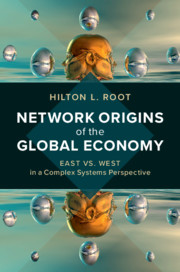Book contents
- Network Origins of the Global Economy
- Network Origins of the Global Economy
- Copyright page
- Dedication
- Contents
- Figures
- Tables
- Contributors
- Preface
- Overview
- Acknowledgments
- Part I Political Economy and Complex Systems
- Part II An Analysis of Historical Regimes
- Part III The Coming Instability
- 7 Has the Baton Passed to China?
- 8 China’s Ambitions and the Future of the Global Economy
- 9 Global Networks over Time
- 10 A Future of Diminishing Returns or Massive Transformation?
- 11 Network Structure and Economic Change: East vs. West
- References
- Index
11 - Network Structure and Economic Change: East vs. West
from Part III - The Coming Instability
Published online by Cambridge University Press: 17 March 2020
- Network Origins of the Global Economy
- Network Origins of the Global Economy
- Copyright page
- Dedication
- Contents
- Figures
- Tables
- Contributors
- Preface
- Overview
- Acknowledgments
- Part I Political Economy and Complex Systems
- Part II An Analysis of Historical Regimes
- Part III The Coming Instability
- 7 Has the Baton Passed to China?
- 8 China’s Ambitions and the Future of the Global Economy
- 9 Global Networks over Time
- 10 A Future of Diminishing Returns or Massive Transformation?
- 11 Network Structure and Economic Change: East vs. West
- References
- Index
Summary
Europe’s network structure had evolutionary advantages in its adaptability in innovation and resistance to collapse. While China’s imperial dynasties bequeathed political, social, and ideological foundations for national unity that endured largely intact for two millennia, behind that legacy resides a source of enduring structural weakness. Its system stability comes at a loss of flexibility. Fear of emerging chaos is memorialized in the narrative by which the Chinese Communist Party justifies its grip on power. An awareness of how vulnerability has led to failures predisposes China’s leaders to take insulating measures, e.g., censoring the Internet, constraining academic course content, imposing party oversight on enterprise, and hindering the acquisition of power and prestige that is independent of the regime. But bolstering system stability by strengthening centralized control mechanisms may undermine system resilience, reproducing the very weaknesses its designers seek to avoid and causing a massive disruption in the future. As these two great cultural systems begin to impinge on one another, network analysis has much to reveal about the choice of separation or integration that is before us.
Keywords
- Type
- Chapter
- Information
- Network Origins of the Global EconomyEast vs. West in a Complex Systems Perspective, pp. 266 - 278Publisher: Cambridge University PressPrint publication year: 2020

